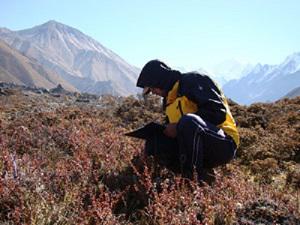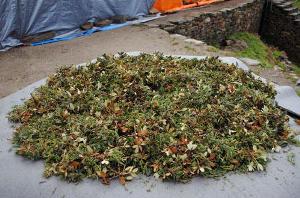Rabindra Parajuli
Project aims to explore positive interactions and interdependencies among high altitude Himalayan plant communities and link it with biodiversity conservation.

One of the team members sampling in Berberis shrub in Kyangjing valley (Oct. 2009).
Langtang National Park, gazetted in 1976, is one of the nearest National Parks from capital city of Nepal, Kathmandu extending to an area of 1710 sq.km. Altitude varies from 792 m on Bhotekoshi to the peak of Langtang Lirung at 7245 m asl. The park is diverse in climatic, floral and faunal composition. It is the first Himalayan National Park in Nepal allowing human settlements inside it. It is experiencing challenges of human settlements. Because of its proximity to capital city, Kathmandu, and the park’s easy accessibility, resources are highly exploited. In alpine environment, environmental severity increases with altitude which impedes normal growth of plants. Over harvesting of plant resources and selection of commercially important plants for conservation removing others, have posed a great threat. In nature, species do not occur independently; rather, complex interactions and interdependences between organisms must be taken into consideration for effective conservation.

Harvested R. anthopogon and Juniper for Incense.
This project will explore positive interactions and interdependencies among high altitude Himalayan plant communities in Langtang National Park, and will link the role of such interactions to the maintenance of species diversity and biodiversity conservation. Project will raise awareness among local people regarding positive plant interactions and biodiversity conservation through educational programs and an observational field visit. These programs will enhance the understanding and knowledge of local inhabitants regarding landscape conservation, which will translate into better conservation practice. Research findings will be shared with policy makers, park officials, government officials, conservationists and other interested parties through workshops. Positive interactions connect ecological communities and preserve global biodiversity. They are common worldwide, occurring when one organism ameliorates the local environment for another, especially in harsh environments. Positive interactions also act against several biotic stresses; herbs, for example, are protected from herbivores by thorny bushes.
Study will focus Langtang-Kyanging valley and Gosaikund area. Due to natural beauty and rich biodiversity, these are highly visited places in the park. These areas harbour many rare, endemic and medicinal plants. These resources are experiencing high anthropogenic pressure. Intensive ecological field research and conservation education programmes will be conducted. Ecological fieldwork in sub-alpine and alpine region will comprise sampling in shrub land and adjacent open land as a control. This intensive ecological research will helps us understand the role of species-specific positive interactions in regulating plant diversity in these systems. Workshops and awareness programs will be conducted to share research findings and knowledge of the landscape approach to conservation.